Capturing vibrant city scenes after dark presents unique challenges and opportunities for photographers. This article explores essential techniques like using a tripod and adjusting camera settings, the impact of different urban environments on nightlife photography, and the importance of composition. It also highlights cultural events that provide dynamic scenes, post-processing tips to enhance images, common challenges faced in low-light conditions, and safety precautions to consider while shooting at night.
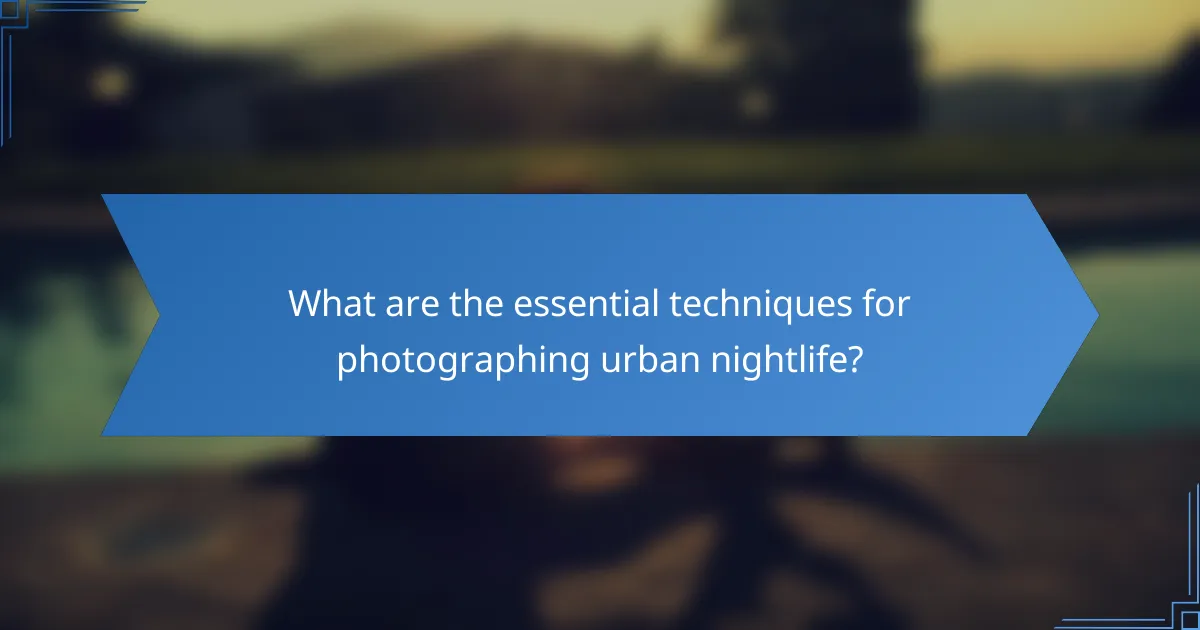
What are the essential techniques for photographing urban nightlife?
To photograph urban nightlife effectively, focus on using a tripod, adjusting your camera settings, and capturing movement. Tripods stabilize your camera for longer exposures, essential for low-light conditions. Set a low ISO to minimize noise and a wide aperture to allow more light. Use slower shutter speeds to create dynamic images with motion blur, highlighting the energy of the city. Additionally, experiment with different angles and compositions to showcase unique urban features.
How does lighting impact urban night photography?
Lighting significantly influences urban night photography by enhancing colours and creating mood. Properly utilized, artificial lights can highlight architectural features and add depth to images. For instance, streetlights, neon signs, and illuminated landmarks create dynamic contrasts. Photographers should consider the colour temperature of lights; warmer tones can evoke a cosy atmosphere, while cooler tones may convey a modern feel. Additionally, experimenting with long exposure can capture light trails, enriching the storytelling aspect of night scenes. Understanding these lighting dynamics is crucial for achieving vibrant and compelling urban night photographs.
What camera settings are optimal for low-light conditions?
Use a wide aperture, slow shutter speed, and higher ISO for optimal low-light photography. A wide aperture (e.g., f/1.8) allows more light, while a slower shutter speed (e.g., 1/30s) captures motion. Adjust ISO to balance brightness and noise. For urban nightlife, stabilizing your camera helps prevent blur.
Which lenses are best suited for capturing vibrant city scenes?
Wide-angle lenses are best suited for capturing vibrant city scenes. They allow photographers to include expansive views and intricate details of urban landscapes. A lens with a focal length of 16-35mm is ideal for this purpose. Additionally, a fast aperture of f/2.8 or wider enables better low-light performance, crucial for nighttime photography. Consider lenses with image stabilization to reduce motion blur during handheld shots.
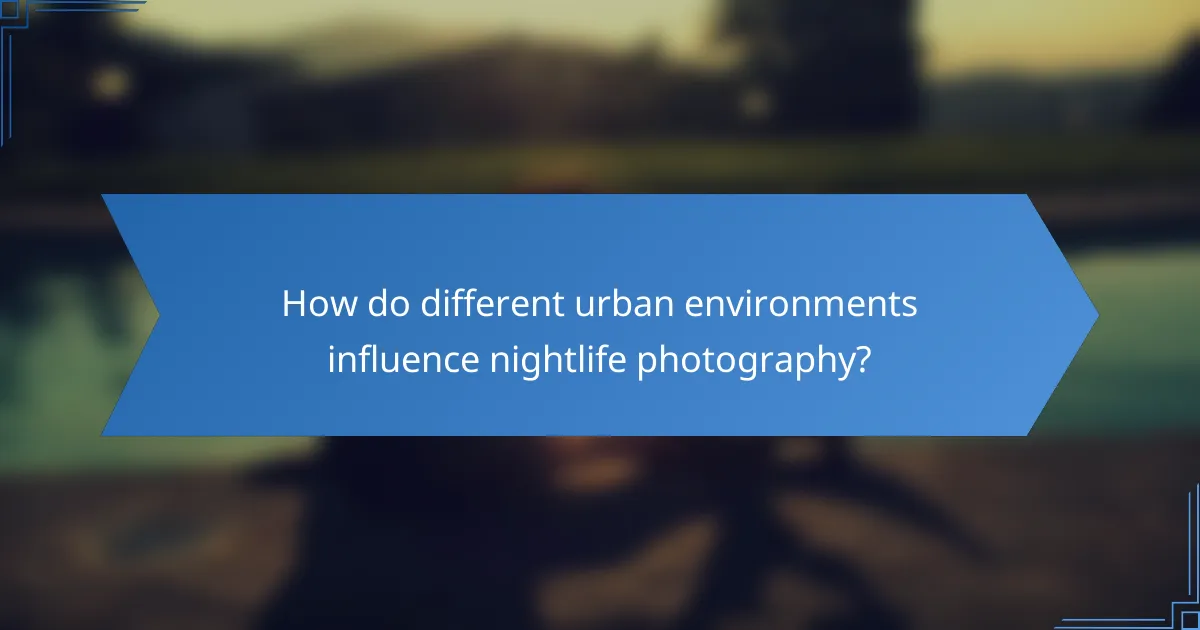
How do different urban environments influence nightlife photography?
Different urban environments significantly influence nightlife photography by affecting lighting, ambiance, and subject variety. Cities with vibrant nightlife offer dynamic scenes, while quieter areas may present unique, intimate moments. Factors like architecture, street art, and local culture shape the visual storytelling. Urban settings with diverse lighting sources, such as neon signs or street lamps, create opportunities for striking contrasts and moods. Understanding these elements enhances the ability to capture compelling images that reflect the essence of each environment.
What unique characteristics do bustling metropolitan areas offer?
Bustling metropolitan areas offer vibrant urban nightlife, characterised by diverse entertainment options, dynamic cultural events, and unique social atmospheres. These cities feature illuminated skylines, lively street performances, and a variety of dining experiences that enhance nighttime photography.
Unique characteristics include the availability of late-night venues, which provide opportunities for capturing spontaneous moments and interactions. Additionally, the blend of architectural styles creates visually compelling backdrops for photography. Rarely, some cities host special nighttime events, such as light festivals, which showcase innovative art installations and enhance the urban landscape.
For photographers, understanding the interplay of artificial lighting and shadows is crucial. Mastering techniques to adjust exposure settings can lead to stunning images that reflect the energy of urban nightlife.
How do tranquil suburban settings change the night photography approach?
Tranquil suburban settings require a different approach to night photography than urban environments. In suburbs, the focus shifts to capturing serene landscapes and ambient light rather than vibrant city scenes.
Suburban night photography emphasizes softer lighting and longer exposures. Photographers can utilize the lack of harsh artificial lights to create dreamy effects. The absence of crowds allows for more controlled compositions, highlighting unique attributes like starry skies or quiet streets.
Additionally, the unique charm of suburban architecture can be showcased through techniques such as light painting or capturing reflections. This contrasts with urban settings where the emphasis is often on dynamic energy and bustling activity.
Understanding these differences enhances the ability to capture the essence of suburban life after dark, offering a distinct narrative through photography.
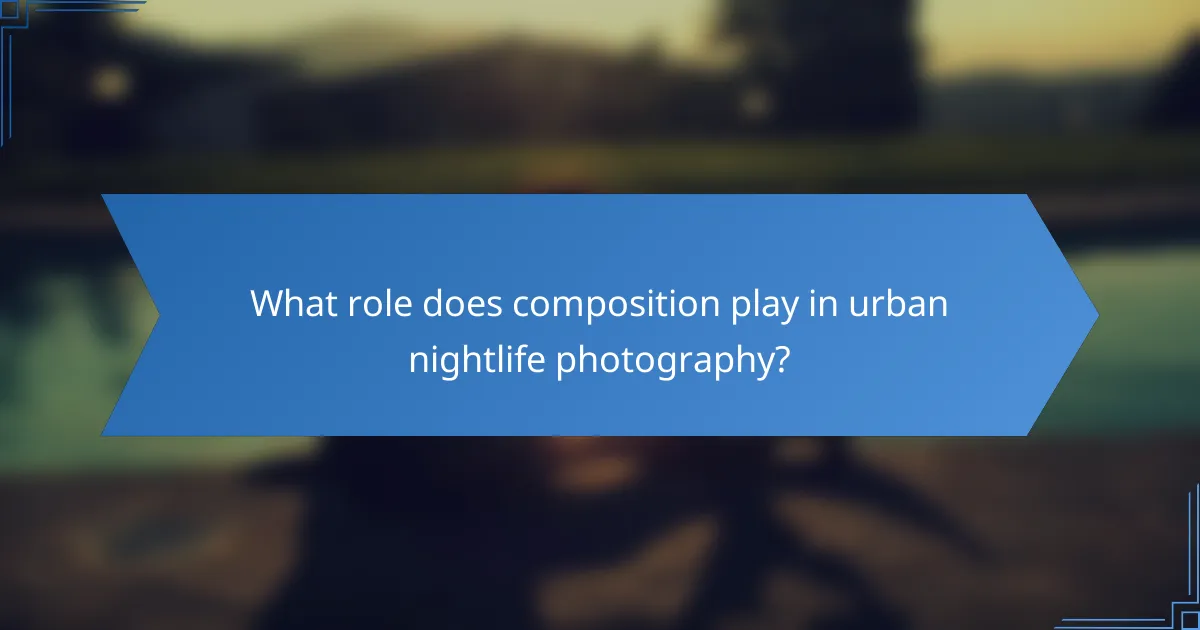
What role does composition play in urban nightlife photography?
Composition plays a crucial role in urban nightlife photography by guiding the viewer’s eye and enhancing storytelling. Effective composition can highlight vibrant city scenes, create depth, and capture the essence of nightlife. Key techniques include the rule of thirds, leading lines, and framing, which help to balance elements within the frame. Additionally, unique attributes like light reflections and urban textures can be emphasized through thoughtful arrangement, making each photograph more engaging. By focusing on these compositional elements, photographers can transform ordinary moments into captivating visual narratives.
How can framing enhance the storytelling aspect of night scenes?
Framing enhances storytelling in night scenes by guiding the viewer’s focus and creating depth. It allows photographers to highlight key elements, such as city lights or interesting architecture, while adding context to the urban environment. Effective framing can evoke emotions and convey narratives, transforming a simple photograph into a compelling story. Techniques like leading lines or natural frames, such as windows or doorways, can further enrich the visual experience, making the scene more engaging and immersive.
What are the best practices for using leading lines in urban settings?
To effectively use leading lines in urban settings, focus on structures like roads, railings, or buildings that guide the viewer’s eye. Utilize these lines to draw attention to focal points and create depth in your photos. Experiment with angles to find the most dynamic compositions, enhancing the vibrancy of city scenes after dark. Pay attention to lighting; illuminated lines can add drama and contrast, making your images more engaging.
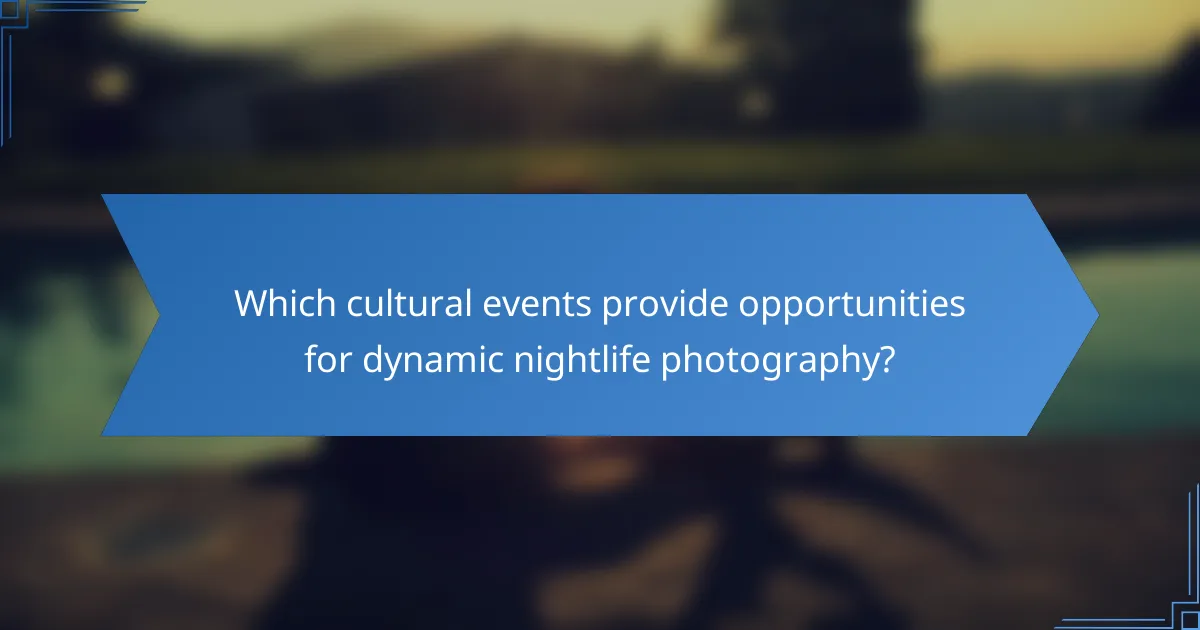
Which cultural events provide opportunities for dynamic nightlife photography?
Cultural events such as music festivals, street fairs, and art walks offer excellent opportunities for dynamic nightlife photography. These events showcase vibrant city scenes, engaging crowds, and unique lighting, ideal for capturing the essence of urban nightlife.
Key events include:
– Music festivals: Features live performances, colourful lights, and energetic crowds.
– Street fairs: Offers diverse cultural displays, food stalls, and lively interactions.
– Art walks: Showcases local artists, illuminated installations, and creative expressions.
– Night markets: Presents bustling vendors, unique products, and atmospheric settings.
– Parades: Highlights vibrant costumes, dynamic movements, and festive energy.
– Cultural celebrations: Captures traditional performances, community gatherings, and rich heritage.
Each of these events presents unique attributes that enhance nightlife photography, providing photographers with diverse scenes to explore and capture.
How do music festivals shape urban nightlife visuals?
Music festivals significantly enhance urban nightlife visuals by creating dynamic, colourful scenes. These events transform city landscapes with vibrant lights, engaging performances, and diverse crowds. Photographers can capture unique attributes like illuminated stages and expressive attendees, showcasing the festival’s atmosphere. The interplay of urban architecture and festival elements offers rare photographic opportunities, emphasizing the city’s cultural vibrancy after dark.
What are the photography opportunities during local night markets?
Local night markets offer diverse photography opportunities, showcasing vibrant scenes and unique cultural elements. Capturing the dynamic atmosphere, colourful stalls, and interactions between vendors and customers enhances urban nightlife photography.
Consider using low-light techniques to highlight neon lights and ambient settings. Experiment with long exposure to create motion blur from bustling crowds. Focus on unique attributes, such as local street food presentations or artisan crafts, to tell compelling stories through your images.
Utilizing different angles and perspectives can reveal the essence of the market’s energy. Candid shots of people enjoying the experience add depth to your portfolio. The variety of subjects, from food to performances, ensures a rich array of photographic opportunities.
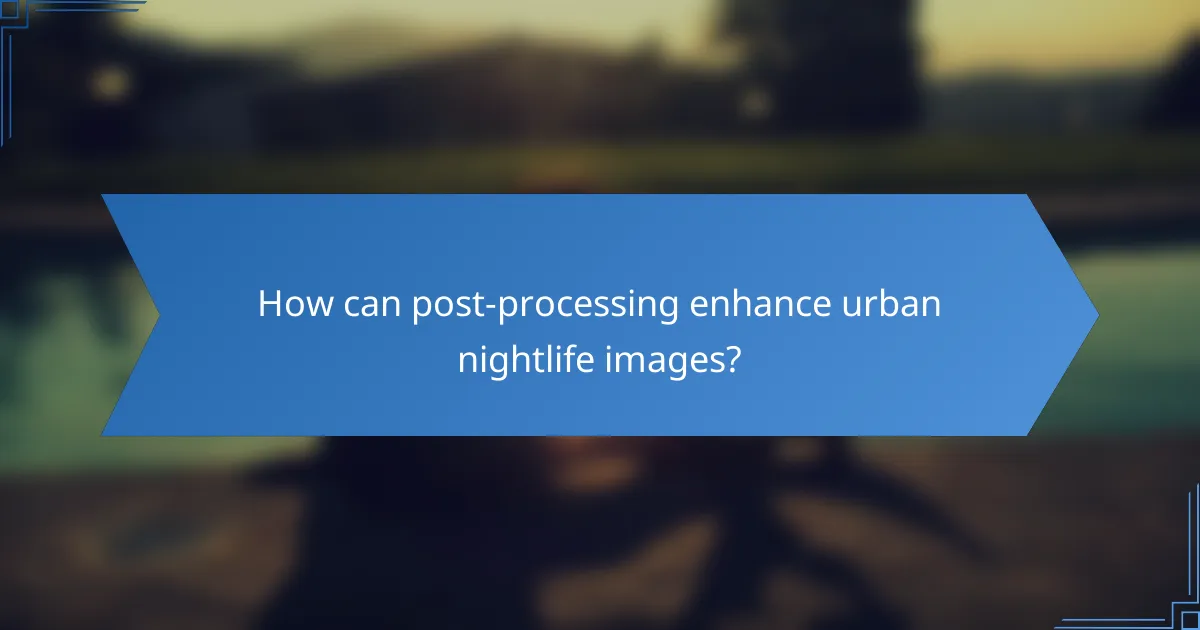
How can post-processing enhance urban nightlife images?
Post-processing enhances urban nightlife images by improving exposure, colour balance, and clarity. Techniques like noise reduction and selective lighting adjustments can highlight vibrant city scenes. Utilizing software tools allows photographers to create a dramatic contrast between lights and shadows, enhancing the overall mood. Additionally, applying presets or filters can unify the aesthetic, making images feel more cohesive and engaging.
What techniques improve colour vibrancy in night photography?
To improve colour vibrancy in night photography, utilize techniques such as long exposures, increased ISO settings, and post-processing adjustments. These methods enhance the richness of urban night scenes.
Long exposures capture more light, revealing vibrant colours in low-light conditions. Increasing ISO allows for better sensitivity to light, helping to maintain colour integrity. Post-processing software can further enhance saturation and contrast, bringing out the vibrancy of city lights and surroundings.
Which software options are popular for editing urban night photos?
Popular software options for editing urban night photos include Adobe Lightroom, Adobe Photoshop, Capture One, and Luminar. These tools offer advanced features for enhancing low-light images, adjusting colours, and improving overall quality. Lightroom excels in batch processing and organization, while Photoshop provides extensive editing capabilities. Capture One is known for its colour grading and tethering features, and Luminar offers AI-driven enhancements for quick adjustments. Each software caters to different editing needs and skill levels, making them suitable for various photographers.
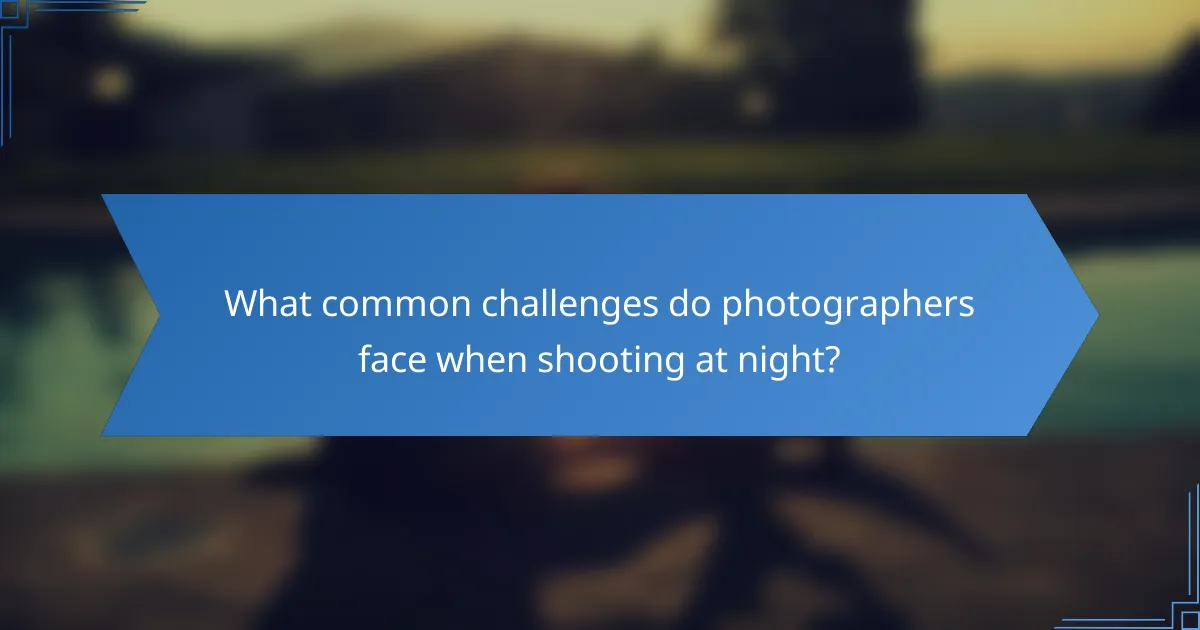
What common challenges do photographers face when shooting at night?
Photographers face several challenges when shooting at night, including low light conditions, camera shake, and focus issues. Low light makes it difficult to capture details without increasing ISO, which can introduce noise. Camera shake often occurs due to longer exposure times required in dim environments. Additionally, autofocus systems struggle in low light, making precise focusing a challenge. These factors can affect the quality and clarity of urban nightlife photography.
How can you effectively manage noise in low-light images?
To effectively manage noise in low-light images, use a combination of techniques. Start by selecting a lower ISO setting to reduce sensitivity to light and minimize grain. Utilize a tripod to stabilize your camera, allowing for longer exposure times without motion blur. Experiment with noise reduction software during post-processing to further enhance image quality. Finally, consider shooting in RAW format to retain maximum detail and flexibility in editing.
What strategies help in capturing moving subjects in nightlife?
To capture moving subjects in nightlife photography, use fast shutter speeds, stabilize your camera, and utilize continuous shooting mode.
Fast shutter speeds reduce motion blur, allowing for crisp images of dynamic scenes. Stabilizing your camera, whether with a tripod or image stabilization features, enhances clarity. Continuous shooting mode enables you to capture multiple frames in quick succession, increasing the chances of getting the perfect shot.
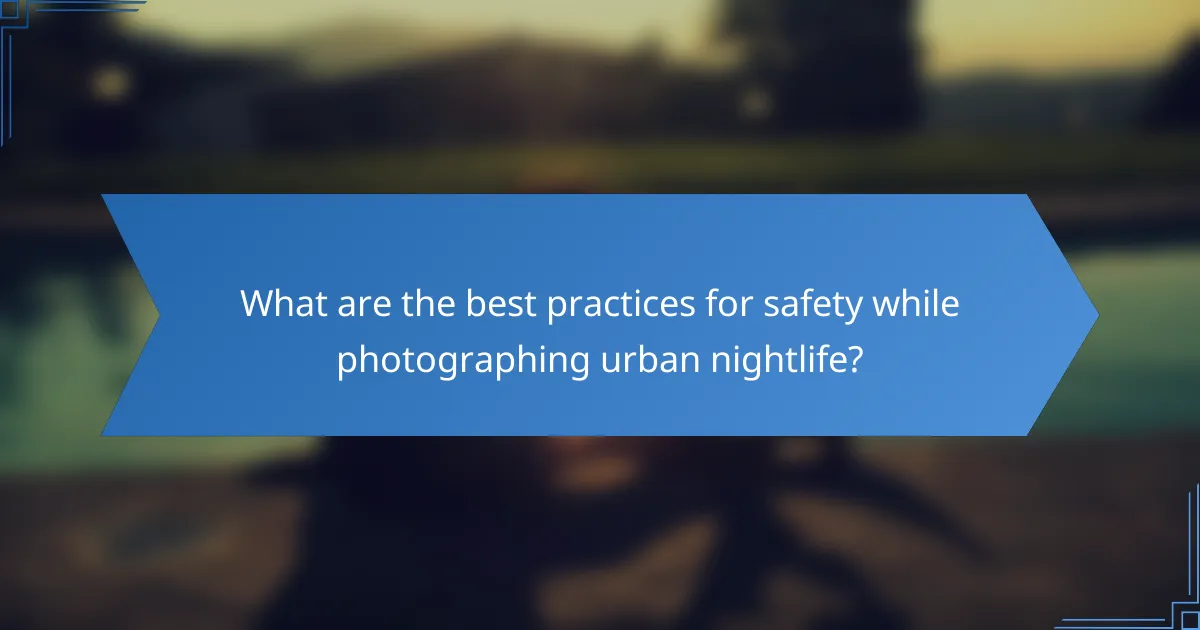
What are the best practices for safety while photographing urban nightlife?
To ensure safety while photographing urban nightlife, stay aware of your surroundings, avoid isolated areas, and secure your equipment. Carry minimal gear to reduce vulnerability and keep your camera close. Use a buddy system when possible, and inform someone of your location. Consider using a discreet camera strap to prevent theft.
How can you choose safe locations for photography at night?
Choose well-lit urban areas with minimal foot traffic and low crime rates for safe night photography. Prioritise locations near popular landmarks, ensuring they have adequate security. Research local crime statistics and scout locations during daylight to assess safety. Consider the presence of other photographers or locals, as this can enhance safety.
What equipment should you carry to ensure personal safety?
To ensure personal safety while photographing urban nightlife, carry essential equipment. A reliable camera with low-light capabilities, a sturdy tripod, and a compact flashlight enhance stability and visibility. Additionally, consider a portable power bank for extended shooting sessions. Always have a personal safety alarm and a map or GPS device for navigation.
What practical tips can improve your urban nightlife photography experience?
To enhance your urban nightlife photography experience, focus on mastering your camera settings and utilising available light. Experiment with long exposures to capture light trails and movement. Use a tripod to stabilize your shots, especially in low-light conditions. Explore different angles and compositions to add depth to your images. Pay attention to the city’s unique attributes, like neon signs and reflections, to create vibrant and dynamic scenes. Always be aware of your surroundings for candid moments that tell a story.